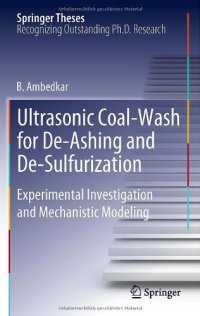
Ebook: Ultrasonic Coal-Wash for De-Ashing and De-Sulfurization: Experimental Investigation and Mechanistic Modeling
Author: B. Ambedkar (auth.)
- Tags: Industrial Chemistry/Chemical Engineering, Physical Chemistry, Engineering Acoustics
- Series: Springer Theses
- Year: 2012
- Publisher: Springer-Verlag Berlin Heidelberg
- Edition: 1
- Language: English
- pdf
This study focuses on the physical aspects of ultrasonic de-ashing and de-sulfurization, such as cavitation, streaming and their combined effects. Ambedkar Balraj proposes an ultrasound-assisted coal particle breakage mechanism and explores aqueous and solvent-based ultrasonic techniques for de-ashing and de-sulfurization. Ambedkar designs a Taguchi L-27 fractional-factorial matrix to assess the individual effects of key process variables. In this volume he also describes process optimization and scale-up strategies. The author provides a mechanism-based model for ultrasonic reagent-based coal de-sulfurization, proposes a flow diagram for ultrasonic methods of high-throughput coal-wash and discusses the benefits of ultrasonic coal-wash. Coal will continue to be a major fuel source for the foreseeable future and this study helps improve its use by minimising ash and sulfur impurities.
This study focuses on the physical aspects of ultrasonic de-ashing and de-sulfurization, such as cavitation, streaming and their combined effects. Ambedkar Balraj proposes an ultrasound-assisted coal particle breakage mechanism and explores aqueous and solvent-based ultrasonic techniques for de-ashing and de-sulfurization. Ambedkar designs a Taguchi L-27 fractional-factorial matrix to assess the individual effects of key process variables. In this volume he also describes process optimization and scale-up strategies. The author provides a mechanism-based model for ultrasonic reagent-based coal de-sulfurization, proposes a flow diagram for ultrasonic methods of high-throughput coal-wash and discusses the benefits of ultrasonic coal-wash. Coal will continue to be a major fuel source for the foreseeable future and this study helps improve its use by minimising ash and sulfur impurities.